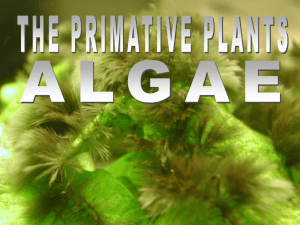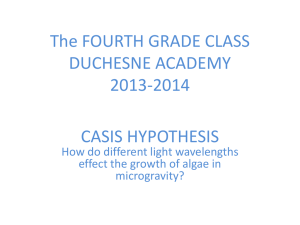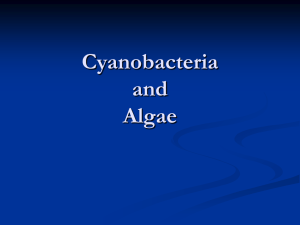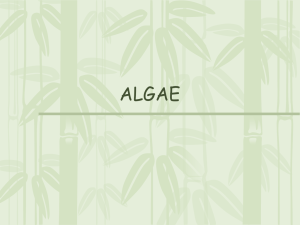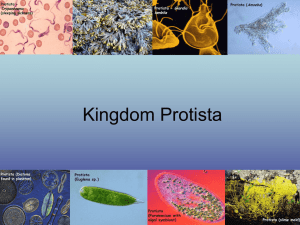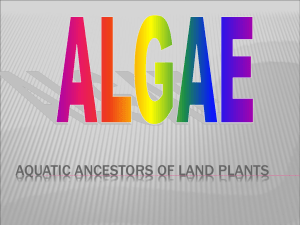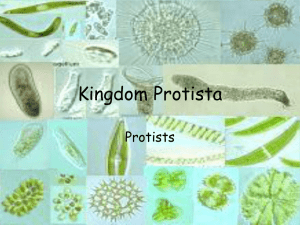Plantlike Protists: Algae
advertisement
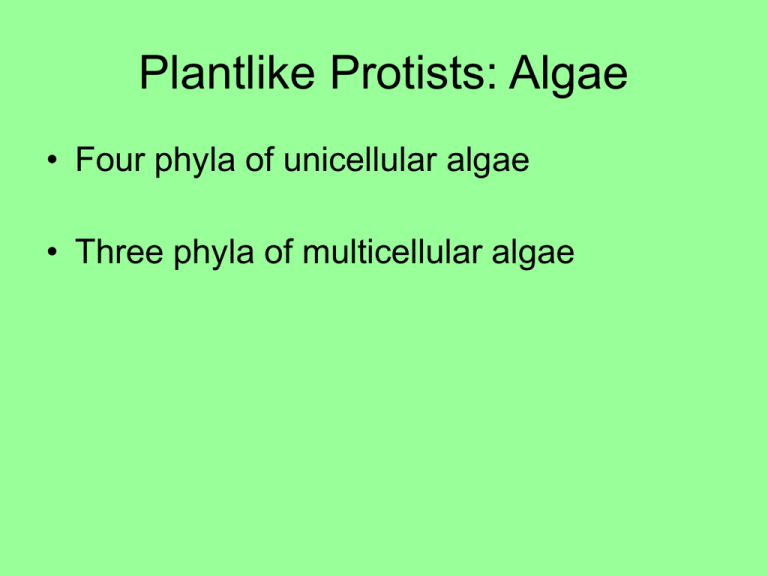
Plantlike Protists: Algae • Four phyla of unicellular algae • Three phyla of multicellular algae Plantlike -unicellular • Cellular characteristics used to classify: – Types of chlorophyll (a,b & c) – Accessory pigments – Absorb different wavelengths of light – Reflect different wavelengths giving algae a wide color range Plantlike -unicellular • Phylum Euglenophyta – Freshwater lentic (still, ponds & lakes) – Chloroplasts – Paired flagella – Swim & can live as heterotrophs! – Reproduce by binary fission Euglena Euglena can become so numerous it may turn the water of a pond bright green. If you keep Euglenids in the dark they start feeding on organic matter and may loose their pigment. There are many species without chloroplasts. Phylum Pyrophyta or dinoflagellates • • • • • ~ 50% autotrophs, 50% heterotrophs Most have two flagella Cellulose “plates” Many are luminescent Genetic mystery Phylum Pyrophyta or dinoflagellates cont. Dinoflagellates (Dinophyta) are flagellated protists. Many species have a beautiful textured armor made of cellulose plates. One of their two flagella runs as a spiral through a groove along the cell. Pyrophyta or dinoflagellates: It is not just protists that use flagella for locomotion. Even our own spermatozoa have a flagellum. Much of the bioluminescence in the sea comes from algae similar to this tropical algae, Pyrocystis fusiformis. Phylum Chrysophyta “Golden plants” Have gold chloroplasts Store food as oil not starch Cell walls may contain pectin Reproduce sexually and asexually Phylum Chrysophyta Phylum Bacillariophyta the diatoms Diatoms One of the most abundant organisms Cell wall of silicon (shells or tests) Shaped like a pill box Remains build up on ocean floor called: Diatomaceous earth – has many uses Filters, abrasives (polishes), plastic products Also produces oil not starch Phylum Bacillariophyta the diatoms Phylum Bacillariophyta the diatoms Important roles of unicellular algae Phytoplankton produce ~ 50% of Earth’s O2 by photosynthesis Phytoplankton are the foundation of the food web in most marine ecosystems Symbionts with coral animals (dinoflagellates) Negative role: HAB- harmful algal blooms 3 (mostly) Multicellular Phyla Red algae - Phylum Rhodophyta Brown algae – Phylum Phaeophyta Green algae – Phylum Chlorophyta RED ALGAE, Phylum Rhodophyta Red algae live at great depths up to 260M Efficient light gathering pigments absorb blue wavelength of light – reflect red wavelength Range in oceans from polar areas to tropics Most are multicellular with a complex life cycle Red Algae,P. Rhodophyta cont. Coralline algae helps stabilize coral reefs Use CaCO3 in cell walls Important food source in Asia Brown algae – Phylum Phaeophyta The largest size and most complex of all algae Kelp “forests” individuals grow up to 60M long Sargasso Sea – huge floating mats of brown algae in the Atlantic near Bermuda Fucus or rockweed has holdfast, stipes (a stem-like structure), bladder, & blades Brown algae – Phylum Phaeophyta Kelp • Kelp forests are found in cold waters • Our Pacific Northwest coastline has kelp forests. Green algae – Phylum Chlorophyta The most diverse group of algae ~ 7,000 species Many species unicellular Marine and freshwater habitats, even moist areas on land Green algae – cont. Likely ancestors to terrestrial plants -Same type of chlorophyll a & b -Cell walls with cellulose -Store food in the form of starch Green algae – cont. Unicellular Reproduction of chlamydomonas Green algae – cont. Colonial green algae Called volvox Green algae – cont. Colonial green algae Filamentous algae Spirogyra: note chloroplasts form spirals Green algae – multicellular sea lettuce

